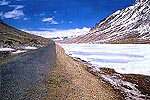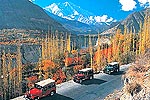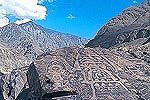For much of its 1,284 kms (905 miles) the Karakoram Highway is overshadowed
by towering barren mountains and a high altitude desert enjoying less than
100 millimeters (four inches) of rain a year. In many of the gorges through
which it passes, it rides a shelf cut into a sheer cliff face as high as
500 meters (1,600 feet) above the river.
 The KKH has opened up Remote villages where
little has changed in hundreds of years, where farmers irrigate tiny terraces
to grow small patches of wheat, barley or maize that stand out like emeralds
against the Grey, stony mountains. The highway is an incredible feat of
Engineering and enduring monuments to the 810 Pakistanis and 82 Chinese
who died forcing it through what is probably the world's most difficult
and unstable terrain. (The unofficial death toll is somewhat higher, coming
to nearly one life for each kilometer of the road). The Karakoram and the
Himalayas, the newest mountain ranges in the world, began to form some
5 million years ago when the Indian sub-continent drifted northwards and
rammed into the Asian landmass. By this time the dinosaurs were already extinct.
The KKH has opened up Remote villages where
little has changed in hundreds of years, where farmers irrigate tiny terraces
to grow small patches of wheat, barley or maize that stand out like emeralds
against the Grey, stony mountains. The highway is an incredible feat of
Engineering and enduring monuments to the 810 Pakistanis and 82 Chinese
who died forcing it through what is probably the world's most difficult
and unstable terrain. (The unofficial death toll is somewhat higher, coming
to nearly one life for each kilometer of the road). The Karakoram and the
Himalayas, the newest mountain ranges in the world, began to form some
5 million years ago when the Indian sub-continent drifted northwards and
rammed into the Asian landmass. By this time the dinosaurs were already extinct.
India is still trundling northwards at the geologically reckless rate of five centimeters (two inches) a year and the mountains are still growing by about seven millimeters (1/4 of an inch), annually. The KKH runs through the middle of this collision belt, where there is an earth tremor, on average, every three minutes. Karakoram is Turkish for 'crumbling rock'; an apt description for the giant, gray, snow-capped slagheaps that towers above the gorges which cut between them.
Three miles North of Hassan Abdal you enter the Hazara region of the North-West
Frontier Province and continue past the bustling town of Haripur to Havelian,
the railhead and official beginning of the Karakorum Highway.
 Next is the large town of Abbottabad, where a road branches east to the hill town of Murree and its neighbours, the
Galis. At Thakot (2,515 feet in elevation and 123 miles from Rawalpindi)the
KKH leaves Hazara and enters Swat District, crossing to the right bank
of the Indus over the first of the more than ninety graceful suspension
bridges built by engineers that lie between here and the northern border.
The Indus River flows northwest, dividing the Himalayas from the Karakoram
before being knocked south, by the Hindukush. The KKH hugs the banks of
the Indus for 310 kilometers of its climb north, winding around the foot
of Nanga Parbat, the ninth highest mountain in the world and the western
anchor of the Himalayas.
Next is the large town of Abbottabad, where a road branches east to the hill town of Murree and its neighbours, the
Galis. At Thakot (2,515 feet in elevation and 123 miles from Rawalpindi)the
KKH leaves Hazara and enters Swat District, crossing to the right bank
of the Indus over the first of the more than ninety graceful suspension
bridges built by engineers that lie between here and the northern border.
The Indus River flows northwest, dividing the Himalayas from the Karakoram
before being knocked south, by the Hindukush. The KKH hugs the banks of
the Indus for 310 kilometers of its climb north, winding around the foot
of Nanga Parbat, the ninth highest mountain in the world and the western
anchor of the Himalayas.
As you proceed north on the KKH, you enter the region called 'Kohistan',
"Land of Mountains". This area was formerly known as 'Yagistan', "Land
of the Ungovernable," or "The Rebellious Country." Along the KKH east of
Buner, the small Gor Valley drains into the far side of the Indus from
the North. At Raikot Village, the raikot valley joins the Indus. Just upriver
from Raikot, the KKH crosses to the north (right) bank of the Indus. Not
far north of Jaglot the Gilgit river joins the Indus from the west.
 The highway then leaves the Indus for Gilgit, Hunza and Khunjerab rivers
to take on the Karakoram Range, which boat 12 of the 30 highest mountains
in the world. By this time the road reaches to 4,733 metre (15,528-feet).
Here, the KKH follows first the Gilgit river, then the Hunza valley to
the road's terminus on the border with Sinkiang, China at the Khunjerab
Pass. The Khunjerab Pass has earned the name of the highest metalled border-crossing
in the world. The KKH continues almost due west along the Gilgit River
valley, crossing dry alluvial fans, and in a dozen miles passes south of
the Bagrot valley, a tributory nala with a road that leads directly north
to the southern base of Rakaposhi, the 25,550-foot peak. Soon you see a
long suspension bridge over the Gilgit river that leads to the town of
Dainyor. The KKH crosses that bridge, carrying on into the gorge of the
hunza river. The remainder of the road follows the hunza valley. The KKH
is indeed a wonder of its own and a must see for all tourists visiting
Pakistan.
The highway then leaves the Indus for Gilgit, Hunza and Khunjerab rivers
to take on the Karakoram Range, which boat 12 of the 30 highest mountains
in the world. By this time the road reaches to 4,733 metre (15,528-feet).
Here, the KKH follows first the Gilgit river, then the Hunza valley to
the road's terminus on the border with Sinkiang, China at the Khunjerab
Pass. The Khunjerab Pass has earned the name of the highest metalled border-crossing
in the world. The KKH continues almost due west along the Gilgit River
valley, crossing dry alluvial fans, and in a dozen miles passes south of
the Bagrot valley, a tributory nala with a road that leads directly north
to the southern base of Rakaposhi, the 25,550-foot peak. Soon you see a
long suspension bridge over the Gilgit river that leads to the town of
Dainyor. The KKH crosses that bridge, carrying on into the gorge of the
hunza river. The remainder of the road follows the hunza valley. The KKH
is indeed a wonder of its own and a must see for all tourists visiting
Pakistan.


